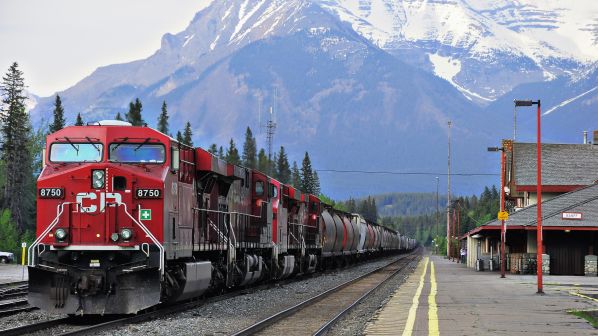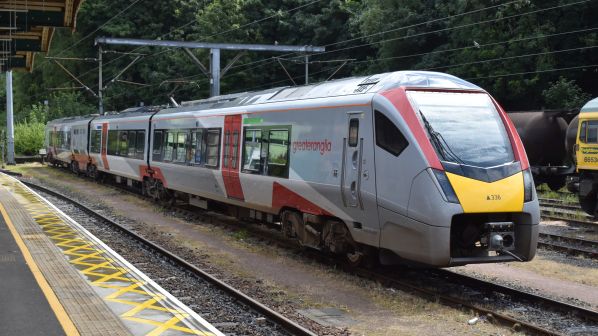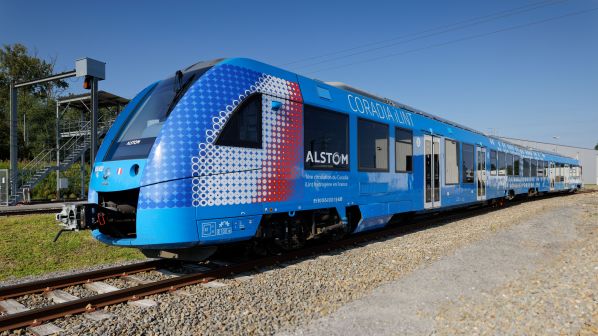PASSENGERS in northern Germany began travelling on the first commercially operated hydrogen trains in September 2018. At the start of September 2021, one of the two Alstom Coradia iLint trains used for those services carried out demonstrations at Alstom’s Valenciennes test centre in northern France, showcasing to the French transport minister, Mr Jean-Baptiste Djebarri, and Alstom France president, Mr Jean-Baptiste Eyméoud, what is possible with a train powered by hydrogen.
Hydrogen technology clusters are emerging in countries including Spain, where suppliers will work with train builders and operators to improve the offering. Similar scenarios are planned in Britain, where local hydrogen infrastructure could serve not just rail vehicles but other local public transport as well as other industries.
Those ideas could then be turned into export opportunities for the supply chains, allowing countries including Spain and Britain to become world-leaders in their fields when it comes to building hydrogen-powered machines including trains.
At the upcoming Conference of the Parties climate change event (COP26) in Glasgow on November 1-12 at least one hydrogen-powered train will carry delegates on the national rail network, while another will be on static display throughout the event.

Momentum is clearly building but hydrogen is not the only option. There appears to be three clear choices for decarbonising the railway: electrification, batteries and hydrogen. Increasingly orders are being placed for trains with more than one form of propulsion, be it diesel-electric, electric-battery or electric-hydrogen.
Researchers and railways ranging from Russia to Korea and the United States are examining the technology and more train builders and train providers are looking to invest in, at the very least, trials with hydrogen-powered rolling stock.
Alstom led the charge to introduce hydrogen in Europe, debuting the iLint hydrogen multiple unit at InnoTrans in Berlin in 2016, before proceeding to the start of passenger operations in Germany. Rival manufacturers including CAF, Pesa, Siemens and Talgo are also now actively looking at how they can develop their own hydrogen trains. And with 20,000 diesel passenger trains still in operation in Europe, the market is promising Indeed, recent news stories emphasise the growing momentum.
Hydrogen strategies
While orders are being placed and agreements signed to progress with various schemes, governments continue to develop their hydrogen strategies. These not only discuss the plans for rail, but also for the countries themselves including the need to develop clusters, where the hydrogen can be sourced from, and how it can be produced in an environmentally-friendly way.
Storage is an issue, with British fleets likely to require tanks fitted inside a coach, meaning a reduction in passenger capacity. Locomotives could require a hydrogen tender similar to that used by steam or LNG locomotives to carry their fuel.
Electrification remains the obvious choice of powering high-performance, high-capacity trains, says Dr Stuart Hillmansen, senior lecturer in electrical energy systems and reader in railway traction systems at the University of Birmingham. “If you want to go fast, and you want to run lots of trains, that’s definitely the way to do it,” he says.
But one of the key reasons why electrification is not the answer for all lines is the cost of these projects. On many routes there is only a marginal business case, or no case at all to put up wires. This is where hydrogen is viewed as a strong contender as an alternative to diesel.
Green hydrogen
Yet hydrogen is not as green as it might seem. The issue of how green the fuel is is raised by Hillmansen who says “green hydrogen” is the preferred fuel type. Green hydrogen is produced through electrolysis, where electricity is used to split water into hydrogen and oxygen - gas from this process is often referred to as ‘green hydrogen’ or zero carbon hydrogen when the electricity comes from renewable sources. In contrast, most hydrogen currently produced and used is “grey hydrogen” that is high carbon, coming from fossil fuels with no carbon capture.
The Dutch iLint trial used green hydrogen with a filling station supplied by Engie. In September 2020, the Province of Groningen published its findings into the trials which stated that refuelling was faster than expected and safe, and that drivers found the behaviour of the train comfortable while it was smooth and easy to drive.
German Rail (DB) is also set to use green hydrogen produced by DB Energy at the DB Regio-Werk site in Tübingen on its trials with two-car Mireo HMUs supplied by Siemens Mobility from 2024.
Hillmansen says that for hydrogen to play a part in our journey to net zero, all current and future production will need to be low carbon. To achieve this, he explains that an electricity supply point plus a water feed is needed to offer a localised usage and storage point for the hydrogen from where it can be compressed before being fed into trains.
This is already possible. Railways are well-versed in having large power supply available. For example, dc rail networks have 33kV and 11kV systems running around them. This means they are already distributing power to a traction transformer rectifier substation. Hillmansen says a traction rectifier substation is halfway to an electrolyser substation with dc required to do the electrolysis. The infrastructure needed for hydrogen would therefore look almost the same as the grey boxes sitting alongside the railway today. But rather than those boxes feeding the dc directly to the railway, it is sent into an electrolyser where the water is split. The hydrogen and oxygen are then produced, and the hydrogen is stored before being pressurised.
“It’s not acceptable to say, well you can have a nice shiny train, but only use it for a few hours a day,” Hillmansen says. “BEMUs only do 50-80km on battery. While there is a lot of criticism of hydrogen, right now it’s the only technological solution that will get anywhere near providing autonomous traction.”
Stuart Hillmansen
While refuelling a hydrogen train can take 15-20 minutes, where this takes place remains one of the questions that those developing the fuel and the trains still need to fully address and understand.
The ambition is for this to happen at a conventional railway depot. However, regulations concerning the quantity of hydrogen that can be stored in any one place are dependent upon the surroundings, such as residential developments.
There are also limitations to the range of hydrogen vehicles and the need for more refuelling points if it is effectively to replace current diesel operation patterns. “With a hydrogen train, we’re never going to be able to get the same range as DMUs, which have a range in excess of 1600km,” Hillmansen says. “So, we’re looking at infrastructure with probably more hydrogen refuelling points than we’ve got for diesel refuelling.”
The German Coradia iLints cover around 1000km per day operating the Buxtehude - Bremervörde - Bremerhaven - Cuxhaven line. Hillmansen says this is the most a hydrogen train can currently achieve before space in the train is really eaten into.
The University of Birmingham has been working on the HydroFlex class 799, Britain’s first hydrogen train, which was converted from a redundant EMU, but it retains its electric capabilities. Unlike the iLint, which is solely powered by hydrogen, HydroFlex also incorporates a battery. Hillmansen says it makes sense to develop trains with dual-mode capabilities as this then reduces the amount of hydrogen that needs storing beside the railway and on the train.
Economics
Inevitably a key question surrounding the future use of hydrogen is cost. Electrification is expensive but brings undoubted benefits in terms of performance and reliability. However, electric trains are cheaper than those that would be powered by either hydrogen or batteries.
Hillmansen suggests that hydrogen trains probably cost around the same as battery-electric trains, but more economic analysis is required. A report by the German government-funded Association for Electronic & Information Technologies (VDE) looking at the cost-effectiveness of battery electric multiple units (BEMUs) and hydrogen electric multiple units (HEMUs) as alternatives to DMUs found that BEMUs could be as much as €59m (35%) cheaper to buy and operate compared with an HEMU. However, the study assumes that only green hydrogen will be used. In reality, the cheaper grey hydrogen will still be used in some cases.
Hillmansen says the preferred approach is to look at services where the hope is to recoup the cost of electrification through the farebox and make an economic price comparison with the total system cost of electrification. He says on dense high-performance routes, electrification will always be the cheapest option. But that changes to hydrogen at around the 15-20 minute headway mark.
Train length and loading gauge are also factors that impact the viability and cost-effectiveness of hydrogen trains. While the associated equipment can be fitted to trains running on certain lines within mainland Europe, for other areas, such as Britain with a restrictive loading gauge, it becomes harder.
“Hydrogen tanks are very safe pieces of engineering,”
Stuart Hillmansen
This raises tough questions, according to Hillmansen. “Maybe we need to be saying that if we want to decarbonise the railway, then we’re going to need slightly longer trains?” he says, adding that existing two-car trains might become three-car sets so that part of the extended interior can accommodate traction equipment. “It is going to be really difficult to store sufficient hydrogen underneath a train to get a really big range with the current technology. It’s about moving the industry along to say that that’s acceptable for the service.”
Furthermore, the issue of storage onboard the train is one that Hillmansen and colleagues have studied. He suggests it could be stored in pods for example, even creating a vehicle not dissimilar to the power pack section on a Stadler Flirt. “Hydrogen tanks are very safe pieces of engineering,” he says. “I wouldn’t see a problem with them having a walkway around them.”

Changes might be achieved by altering the pressure of the hydrogen to use 700bar rather than 300bar. Hillmansen suggests that the industry needs to consider this more and select a pressure that then becomes the standard.
Another potential shortcoming of hydrogen technology is the relatively high volumetric energy density. The efficiency of the hydrogen production process whereby producers will use electricity to make hydrogen, which is then used to make electricity again is another obvious limitation.
“Right now we don’t have an alternative,” Hillmansen says, pointing out that batteries are not likely to ever have the power or energy density needed for really heavy applications.
For example, the Roy Hill heavy-haul battery trial announced in September foresees the use of the battery locomotive in a consist with a diesel unit. Batteries may make huge strides for the automotive sector, but a car is generally only used for a few hours a day.
“It’s not acceptable to say, well you can have a nice shiny train, but only use it for a few hours a day,” Hillmansen says. “BEMUs only do 50-80km on battery. While there is a lot of criticism of hydrogen, right now it’s the only technological solution that will get anywhere near providing autonomous traction.”
Rail could also benefit from plans to build clusters of businesses that can be powered by alternative fuel. “There’s obviously a benefit from being close to one of these hubs,” Hillmansen admits, but he believes it is still a case of learning how to manage a transition to a hydrogen economy. Inevitably some hubs will be developed first but he says there is no reason why railway storage facilities cannot be added.
To maximise the viability of hydrogen, consideration must be given to situations where trains are potentially a long way from a hub. The development of a local grid, or the local transport of fuel from a hub to the train have been mentioned as possible strategies. However, the potential logistical challenges of this approach are problematic, inevitably bringing us back to electrification.
Hillmansen says in various railway strategies up to 2050 there is a strong appetite for electrification around the world with a marginal role for batteries and hydrogen. However, he’s adamant that over the next 29 years companies across the globe will become more efficient in producing battery and/or hydrogen trains, increasing their attractiveness and competitiveness. “More than likely they will have good range capability and good performance, which will probably make some of the proposed electrification schemes redundant,” he says. This would certainly be attractive to those making the financial decisions.
“My gut feeling is the people who develop the vehicles around the world are making really good progress and they will offer trains that work pretty well.”
Hydrogen is in the running to become one of the answers to decarbonisation although it needs further development. And that is the key - getting the answers required to make the decisions to proceed with this promising but challenging technology.

